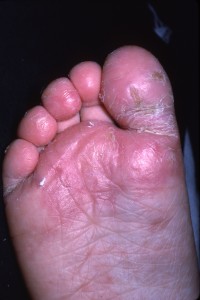No, not at all. Charles Arthur in the Guardian on March 27th 2013 writes that the Language Council of Sweden (who are responsible for the addition of official new words to the Swedish lexicon or language) had noted the increase in use of the term ‘conversesjukan’ or Converse disease, in English. This is meant to mean bad feet or posture caused by wearing trendy trainers.
So?
It is interesting that dermatologists also have their own term for such a condition (namely the bad feet part, not the posture part). Dermatologists love Latin sounding names and the longer the better and this condition does not disappoint. We call it Juvenile Plantar Dermatosis, ie a skin condition of the soles of the feet of young people.
What does it look like?
We describe it as looking like a glazed erythema, namely where the skin on the soles of the feet takes on a red, shiny appearance which can also crack. It is usually symmetrical, involves the forefoot (the ball of the foot and the pads) and doesn’t involve the skin between the toes (unlike a fungal infection which usually does).
What causes it?
The exact cause is not known but the condition is seen generally in children, especially those who wear trainers for prolonged periods of the day. It has been suggested that the synthetic materials in modern-day trainers are less porous than traditional natural materials such as cotton, wool and leather and therefore the feet sweat more and the sweat is retained in the shoe, exacerbating the condition. Many of the affected children play a lot of sport and so friction may also play a part.
What is the treatment?
Obviously, the standard advice is to reduce the wearing of trainers as much as possible and to change to leather shoes and sandals and 100% cotton socks. An alternative would be to treat the condition as a form of foot eczema, with moisturisers and steroid creams. However, fortunately for most, many seem to clear later on in teenager-hood.
Regards,
Sandy
Dr Sandy Flann, Consultant Dermatologist

